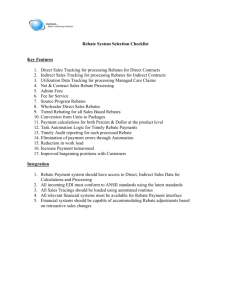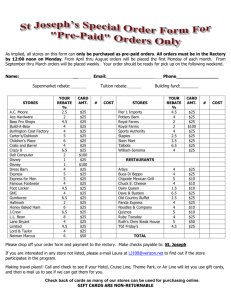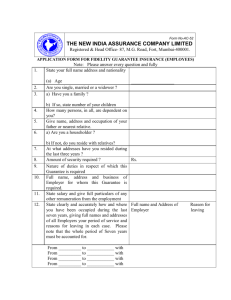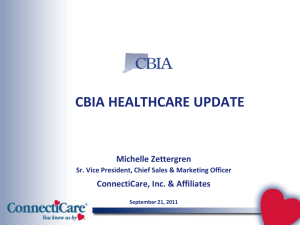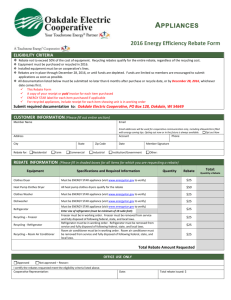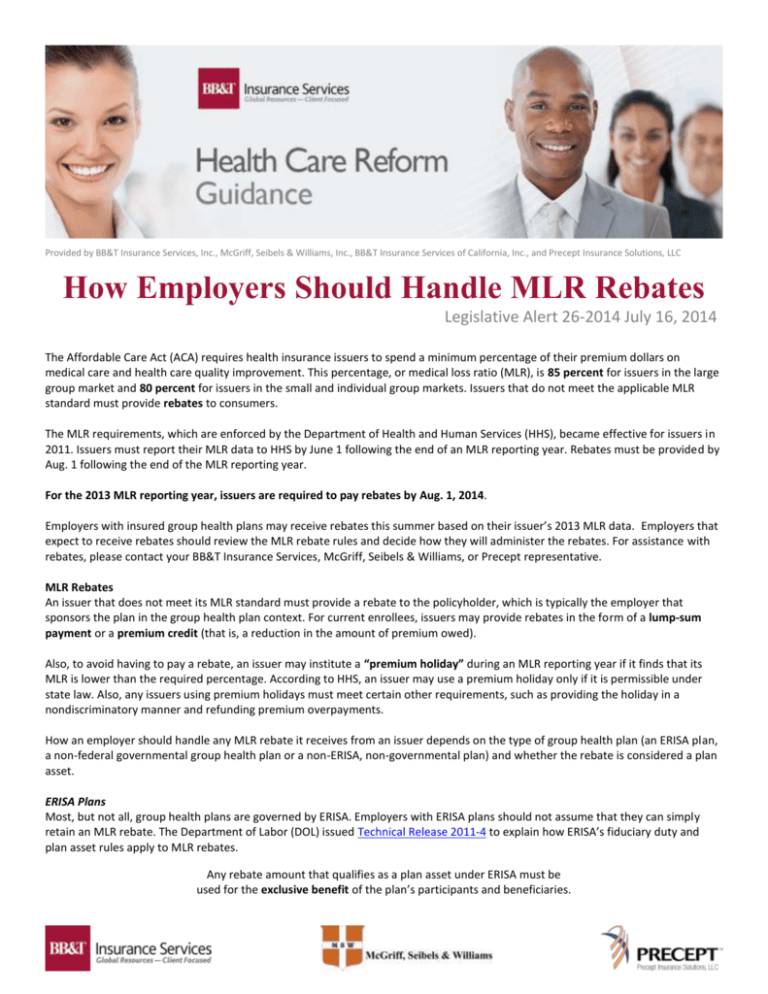
Provided by BB&T Insurance Services, Inc., McGriff, Seibels & Williams, Inc., BB&T Insurance Services of California, Inc., and Precept Insurance Solutions, LLC
How Employers Should Handle MLR Rebates
Legislative Alert 26-2014 July 16, 2014
The Affordable Care Act (ACA) requires health insurance issuers to spend a minimum percentage of their premium dollars on
medical care and health care quality improvement. This percentage, or medical loss ratio (MLR), is 85 percent for issuers in the large
group market and 80 percent for issuers in the small and individual group markets. Issuers that do not meet the applicable MLR
standard must provide rebates to consumers.
The MLR requirements, which are enforced by the Department of Health and Human Services (HHS), became effective for issuers in
2011. Issuers must report their MLR data to HHS by June 1 following the end of an MLR reporting year. Rebates must be provided by
Aug. 1 following the end of the MLR reporting year.
For the 2013 MLR reporting year, issuers are required to pay rebates by Aug. 1, 2014.
Employers with insured group health plans may receive rebates this summer based on their issuer’s 2013 MLR data. Employers that
expect to receive rebates should review the MLR rebate rules and decide how they will administer the rebates. For assistance with
rebates, please contact your BB&T Insurance Services, McGriff, Seibels & Williams, or Precept representative.
MLR Rebates
An issuer that does not meet its MLR standard must provide a rebate to the policyholder, which is typically the employer that
sponsors the plan in the group health plan context. For current enrollees, issuers may provide rebates in the form of a lump-sum
payment or a premium credit (that is, a reduction in the amount of premium owed).
Also, to avoid having to pay a rebate, an issuer may institute a “premium holiday” during an MLR reporting year if it finds that its
MLR is lower than the required percentage. According to HHS, an issuer may use a premium holiday only if it is permissible under
state law. Also, any issuers using premium holidays must meet certain other requirements, such as providing the holiday in a
nondiscriminatory manner and refunding premium overpayments.
How an employer should handle any MLR rebate it receives from an issuer depends on the type of group health plan (an ERISA plan,
a non-federal governmental group health plan or a non-ERISA, non-governmental plan) and whether the rebate is considered a plan
asset.
ERISA Plans
Most, but not all, group health plans are governed by ERISA. Employers with ERISA plans should not assume that they can simply
retain an MLR rebate. The Department of Labor (DOL) issued Technical Release 2011-4 to explain how ERISA’s fiduciary duty and
plan asset rules apply to MLR rebates.
Any rebate amount that qualifies as a plan asset under ERISA must be
used for the exclusive benefit of the plan’s participants and beneficiaries.
Is the Rebate a Plan Asset?
According to Technical Release 2011-4, in the absence of specific plan or policy language addressing these types of distributions,
whether the rebate will constitute a plan asset depends, in part, on the identity of the policyholder and on the source of premium
payments.
If the plan or its trust is the policyholder, the policy is an asset of the plan and the entire rebate must be treated as a
plan asset.
If the employer is the policyholder, as is most often the case, the portion of the rebate that must be treated as a plan
asset depends on who paid the insurance premiums. For example:
o If the premiums were paid entirely out of trust assets, the entire rebate amount is a plan asset;
o If the employer paid 100 percent of the premiums, the rebate is not a plan asset and the employer can retain
the entire rebate amount;
o If participants paid 100 percent of the premiums, the entire rebate amount is a plan asset; and
o If the employer and participants each paid a fixed percentage of the premiums, the percentage of the rebate
equal to the percentage of the cost paid by participants is a plan asset.
Also, if the employer was required to pay a fixed amount and participants were responsible for paying any additional costs, the
portion of the rebate that does not exceed the participants’ total amount of contributions for the MLR reporting period would be a
plan asset. If participants paid a fixed amount and the employer was responsible for paying any additional costs, the portion of the
rebate that does not exceed the employer’s total amount of contributions during the MLR reporting year would not be a plan asset.
In any case, under the DOL’s guidance, employers are generally prohibited from retaining a rebate amount greater than the total
amount of premiums and other plan expenses paid by the employer.
How Should the Rebate Be Used?
Once an employer determines that all or a portion of an MLR rebate is a plan asset, it must decide how to use the rebate for the
exclusive benefit of the plan’s participants and beneficiaries. DOL Technical Release 2011-04 identifies the following methods for
applying the rebates:
The rebate can be distributed to participants under a reasonable, fair and objective allocation method. If the employer
finds that the cost of distributing shares of a rebate to former participants approximates the amount of the proceeds,
the fiduciary may decide to limit rebates to current participants. Also, an allocation does not fail to be impartial merely
because it does not exactly reflect the premium activities of participants.
If distributing payments to participants is not cost-effective because the amounts are small or would give rise to tax
consequences to the participants, the employer may utilize the rebate for other permissible plan purposes, such as
applying the rebate toward future participant premium payments or toward benefit enhancements.
If a plan provides benefits under multiple policies, the employer must be careful to allocate the rebate for a particular policy only to
the participants who were covered by that policy. According to the DOL, using a rebate generated by one plan to benefit another
plan’s participants would be a breach of fiduciary duty.
Is There a Time Limit for Using Rebates?
To the extent a rebate qualifies as a plan asset, ERISA would generally require the amount to be held in trust. However, most group
health plans receiving rebates do not maintain trusts because their premiums are paid from the employer’s general assets (including
employee payroll deductions). In Technical Release 2011-4, the DOL provides relief from the trust requirement for premium rebates
that are used within three months of their receipt.
In addition, directing an issuer to apply the rebate toward future participant premium payments or toward benefit enhancements
adopted by the plan sponsor would avoid the need for a trust and, in some circumstances, may be consistent with the employer’s
fiduciary duties. Employers that decide to take this approach should coordinate with their insurance issuers to establish the process
for handling rebates.
This Legislative Brief is not intended to be exhaustive nor should any discussion or opinions be construed as legal advice. Readers should contact legal counsel for legal advice. Design ©2012-2014 Zywave, Inc. All rights
reserved. 7/12, EM 7/14
The information provided should not be considered tax or legal advice. Please consult with your individual tax advisor and/or attorney regarding your individual circumstances. Insurance products and services are offered
by BB&T Insurance Services, Inc., or McGriff, Seibels & Williams, Inc., both subsidiaries of BB&T Insurance Holdings, Inc. BB&T Insurance Services, Inc., CA Lic #0C64544. Precept Insurance Solutions, LLC, CA Lic # 0747466.
McGriff, Seibels & Williams, Inc., CA license #0E83682.
© 2014, Branch Banking and Trust Company. All rights reserved.
Insurance.BBT.com
Page 2
Non-federal Governmental Plans
Group health plans maintained by non-federal government employers (for example, state and local governments) are not governed
by ERISA’s fiduciary standards. HHS’ interim final regulations on the MLR rules address how rebates for these plans should be
handled.
Under these regulations, employers must use the portion of the rebate attributable to the amount of premium paid by employees in
one of the following ways:
To reduce subscribers’ portion of the annual premium for the subsequent policy year for all subscribers covered under
any group health policy offered by the plan;
To reduce subscribers’ portion of the annual premium for the subsequent policy year for only those subscribers covered
by the group health policy on which the rebate was based; or
To provide a cash refund only to subscribers that were covered by the group health policy on which the rebate is based.
In all three cases, the rebate is used to reduce premiums or is paid to subscribers enrolled during the year in which the rebate is
actually paid, rather than the MLR reporting year on which the rebate was calculated. Whichever method is selected, the
policyholder may choose to divide the reduction or refund evenly among the subscribers, divide it based on each subscriber’s actual
contributions to the premium or apportion it in a manner that reasonably reflects each subscriber’s contributions to the premium.
Non-ERISA, Non-governmental Plans (Church Plans)
HHS has also addressed rebates for non-governmental group health plans that are not subject to ERISA, such as church plans. Under
HHS final regulations, an issuer may make a rebate payment to the policyholder (typically, the employer sponsoring the plan) if it
receives the policyholder’s written assurance that the rebate will be used for the benefit of current subscribers using one of the
options described above for non-federal governmental plans. Without this written assurance, issuers must pay the rebate directly to
employees covered under the policy during the MLR reporting year.
If a church plan is covered by ERISA, the standard rules for ERISA plan assets will apply.
Tax Treatment of Rebates
The Internal Revenue Service (IRS) issued a set of frequently asked questions (FAQs) addressing the tax treatment of MLR rebates. In
general, the rebates’ tax consequences depend on whether employees paid their premiums on an after-tax or a pre-tax basis.
After-tax Premium Payments
If premiums were paid by employees on an after-tax basis, the rebate will generally not be taxable income to employees and will not
be subject to employment taxes. This tax treatment applies if the rebate is paid in cash or if it is applied to reduce current year
premiums. However, if an employee deducted the premium payments on his or her prior year taxes, the rebate is taxable to the
extent the employee received a tax benefit from the deduction.
Pre-tax Premium Payments
If premiums were paid by employees on a pre-tax basis under a cafeteria plan, the rebate will generally be taxable income to
employees in the current year and will be subject to employment taxes. This is the case whether the rebate is paid in cash or is
applied to reduce current year premiums. A premium reduction in the current year will reduce the amount that an employee can
contribute on a pre-tax basis. Thus, there is a corresponding increase in the employee’s taxable salary that is also wages subject to
employment taxes.
Changes for 2014 Reporting Year
On March 1, 2013, HHS issued a final rule to amend the MLR program. The changes made by the final rule ensure that, beginning in
2014, issuers include premium stabilization amounts in MLR and rebate calculations. The final rule extends the annual MLR reporting
deadline from June 1 to July 31 and the rebate disbursement deadline from Aug. 1 to Sept. 30, effective for the 2014 MLR reporting
year.
This Legislative Brief is not intended to be exhaustive nor should any discussion or opinions be construed as legal advice. Readers should contact legal counsel for legal advice. Design ©2012-2014 Zywave, Inc. All rights
reserved. 7/12, EM 7/14
The information provided should not be considered tax or legal advice. Please consult with your individual tax advisor and/or attorney regarding your individual circumstances. Insurance products and services are offered
by BB&T Insurance Services, Inc., or McGriff, Seibels & Williams, Inc., both subsidiaries of BB&T Insurance Holdings, Inc. BB&T Insurance Services, Inc., CA Lic #0C64544. Precept Insurance Solutions, LLC, CA Lic # 0747466.
McGriff, Seibels & Williams, Inc., CA license #0E83682.
© 2014, Branch Banking and Trust Company. All rights reserved.
Insurance.BBT.com
Page 3

